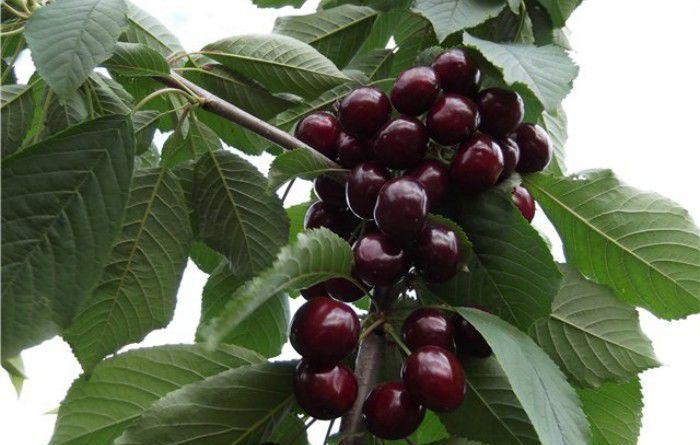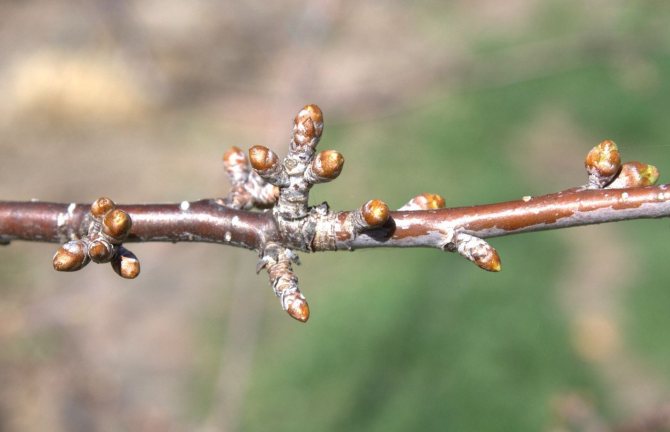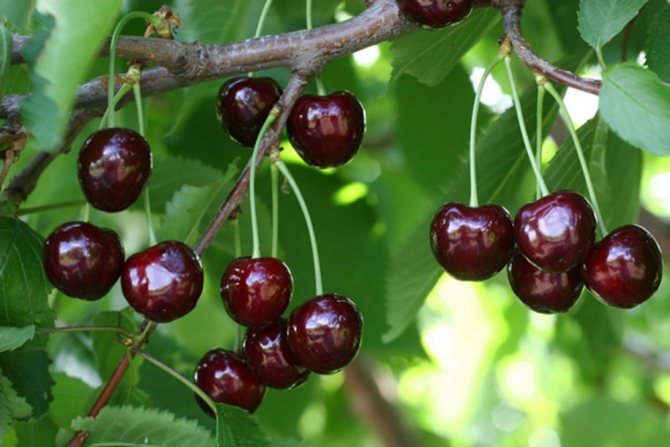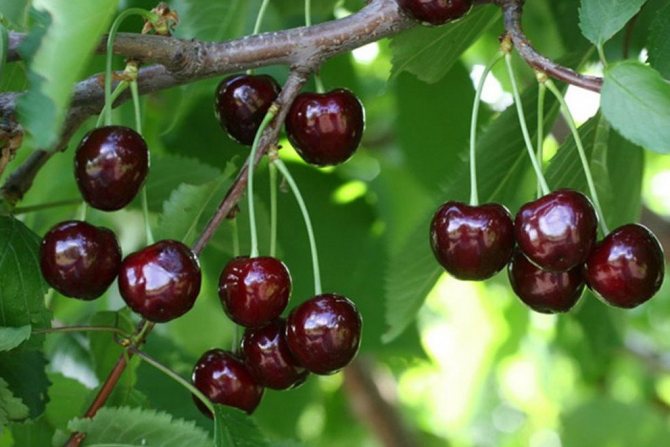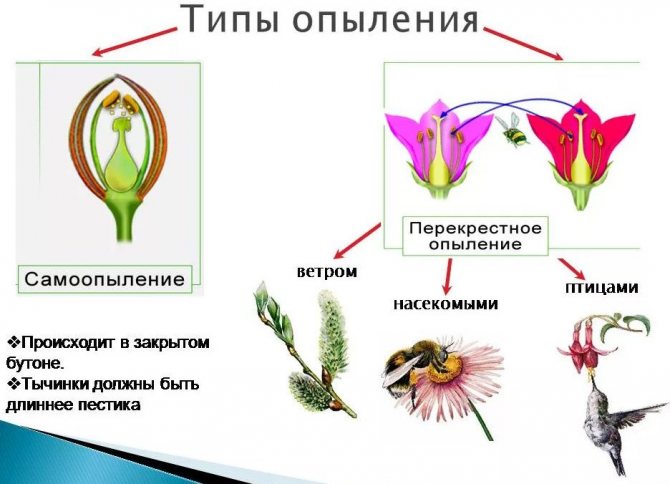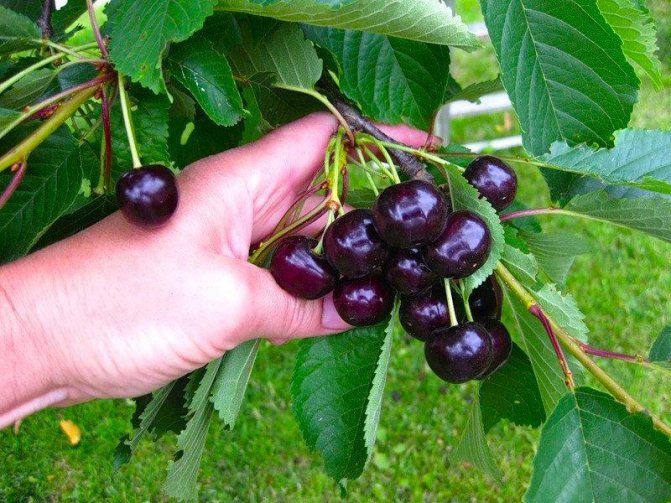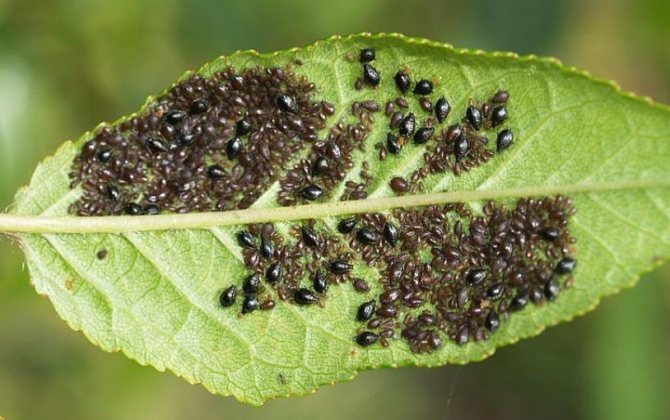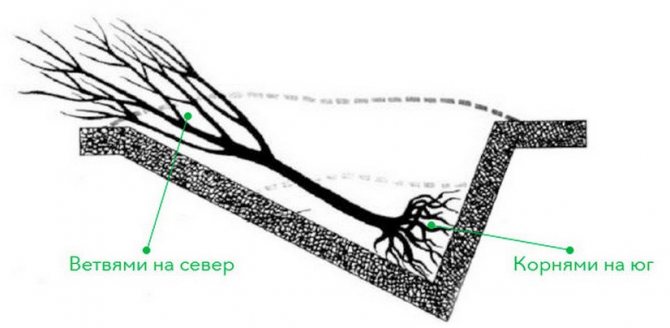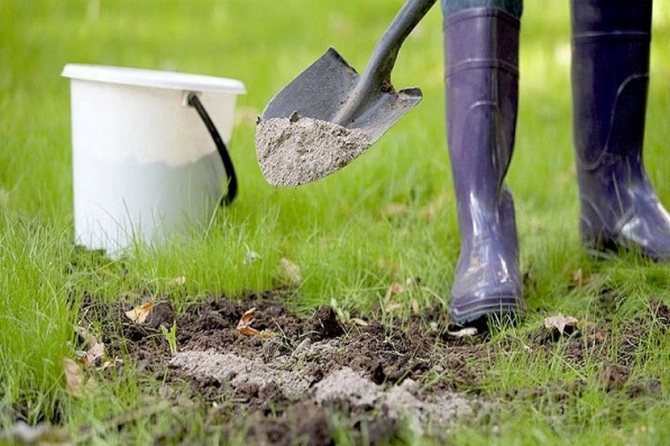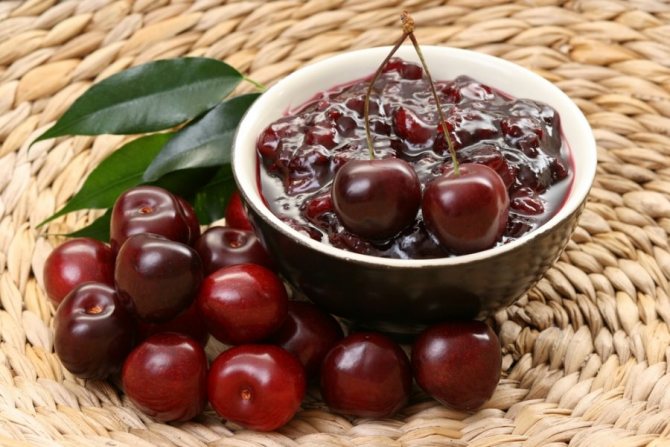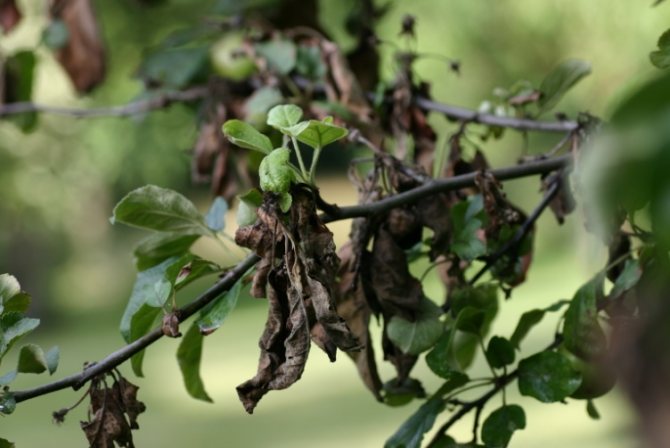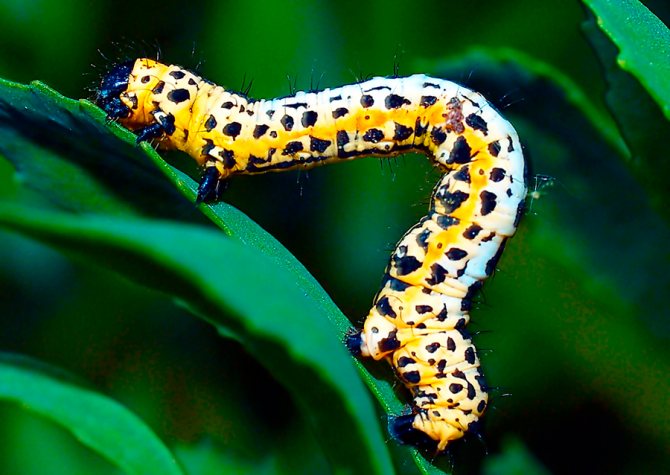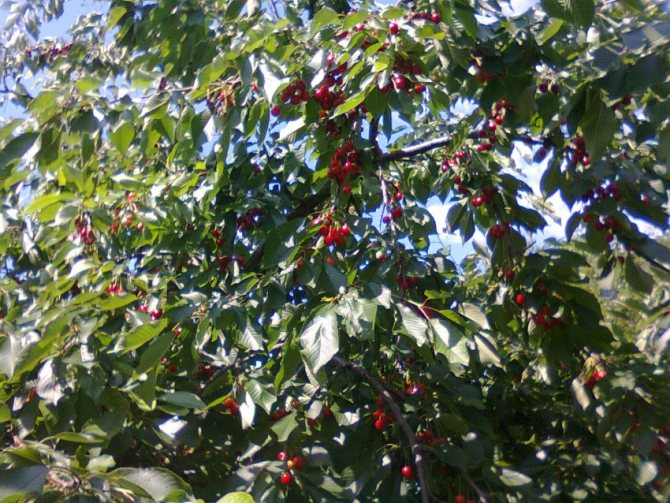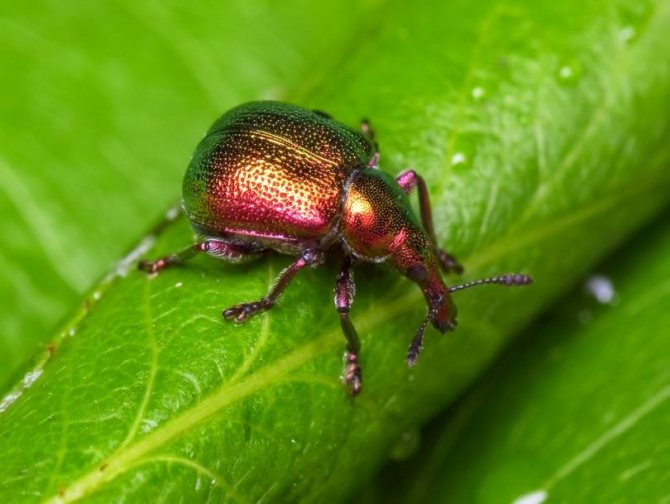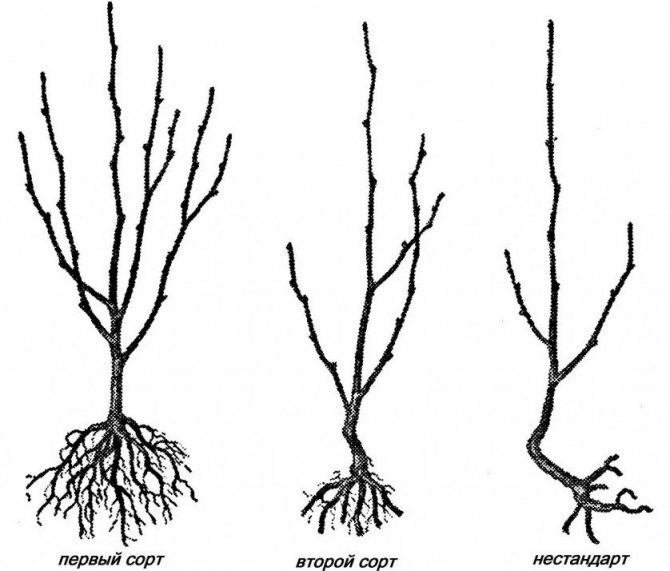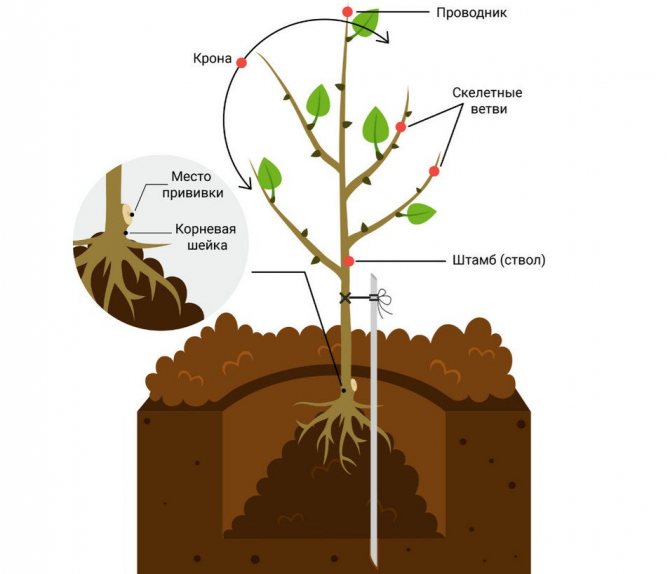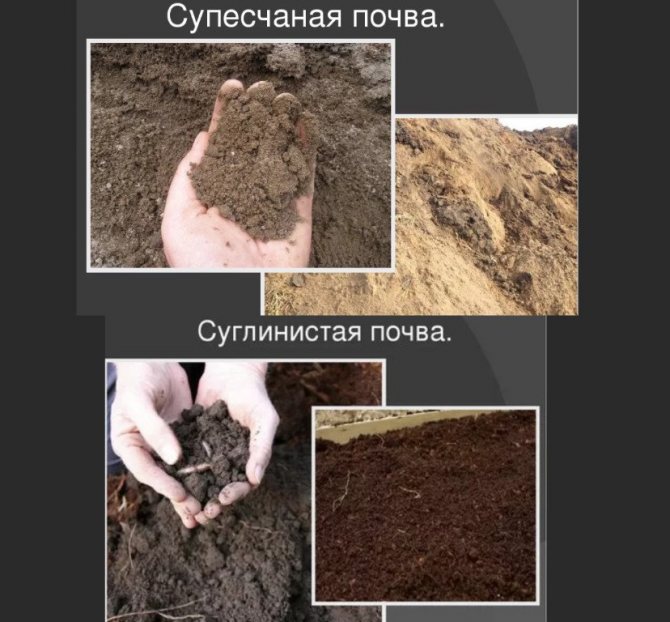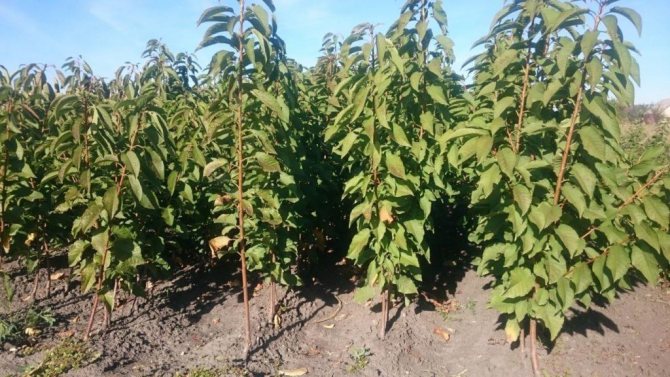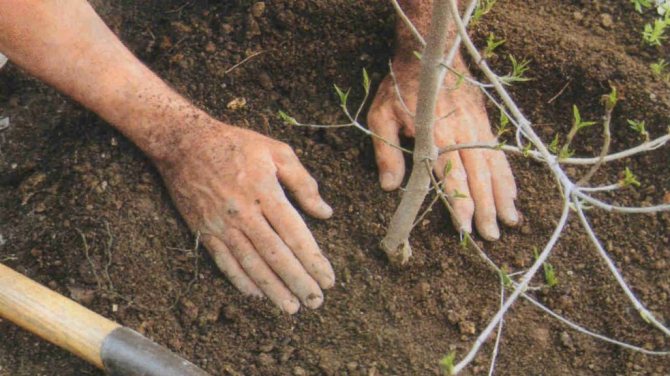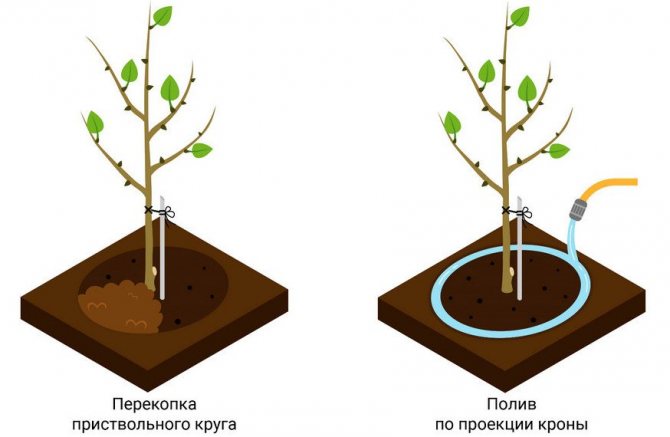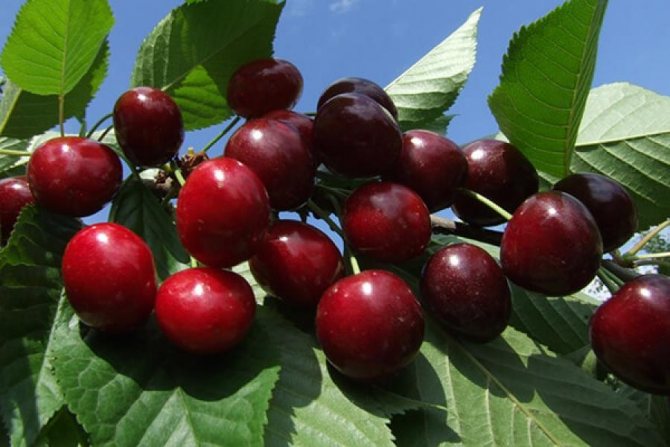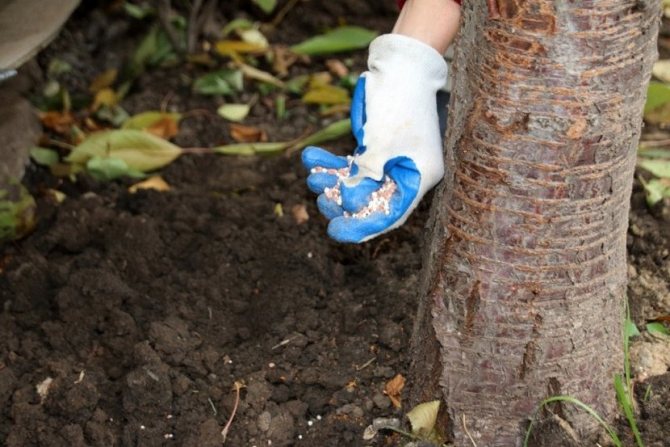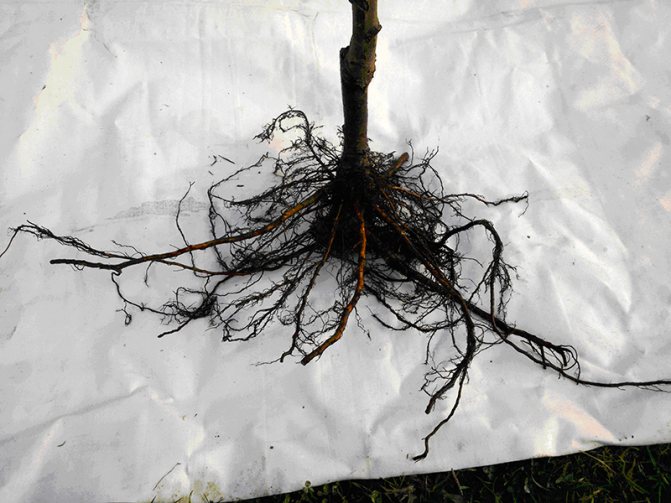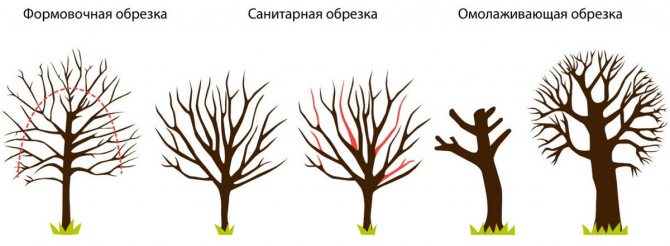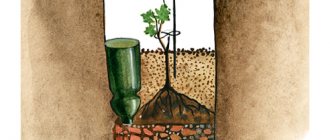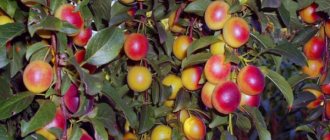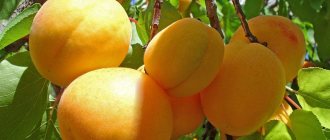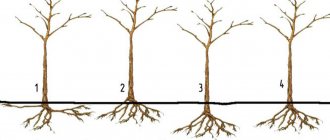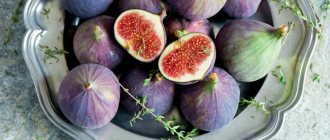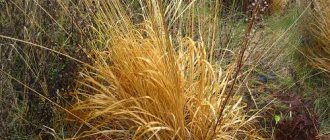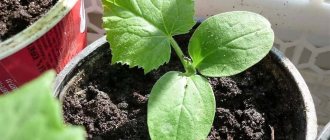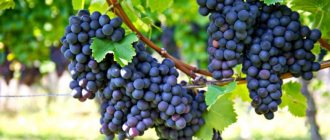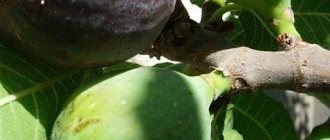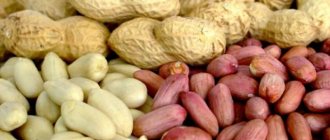It is believed that sweet cherry is a southern berry. However, many frost-resistant varieties have appeared in Russia, suitable for cultivation in cold climates. Among them is the Revna variety - a medium-late ripening cherry that yields stable yields of medium-sized sweet berries that are easy to transport due to their strong skin.
- Advantages and disadvantages of the Revna variety
- Landing features
Sapling selection
- Landing dates
- Seat selection
- Soil preparation
- Landing
- Video: planting cherries Revna
- Soil care
- Table: diseases of the cherry Revna and their treatment
Description of the Revna variety
Cherry Revna, ripening in mid-late periods, was bred by breeders M.V. Kanshina and A.I. Astakhov. Since 1994, this variety has been recommended for cultivation in the Central Region, although by now it can be found in many other regions.
The tree is medium in size and grows intensive. The strong crown has a pyramidal shape and moderate thickening. Straight, not too thick shoots extend from the trunk at a steep angle. Large, rather thick and wide leaves on a short petiole have a dark green color and a finely serrated edge.
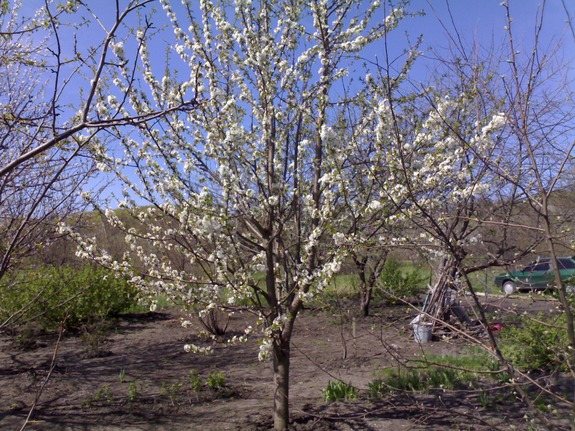
Sweet cherry always blooms profusely, but to get a harvest you need to have other pollinating varieties nearby
Cherry blossoms in mid-May. White, medium-sized flowers are collected in inflorescences of 4 pieces.
Most of the ovaries are formed on bouquet twigs, although the bases of annual shoots are also fruit wood.
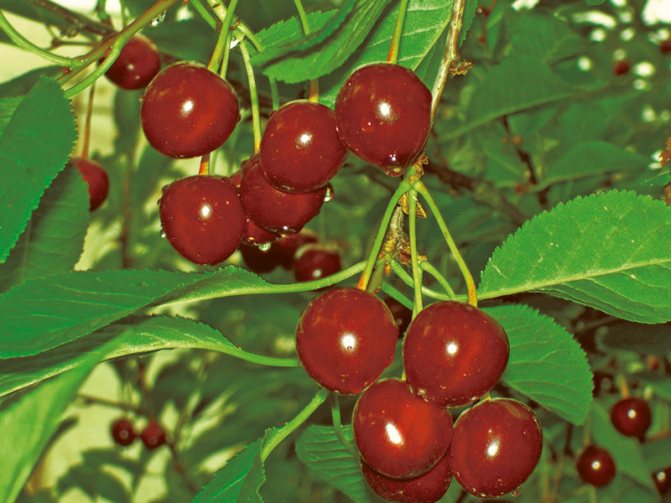

Ravna berries are medium in size.
The fruits of Revna are not too large (weight 4.5–5 g, maximum - 7.7 g), round, covered with a glossy dense skin of dark red color. A characteristic feature is the one-dimensionality of the berries. The dense and juicy flesh has the same color as the skin. The taste is sweet, dessert. Berries contain a lot of sugars - 12.6%, and ascorbic acid - 13.3 mg per 100 g. Medium-sized light brown stone is easily separated from the pulp.
Gardeners reviews
Another great cherry for them in company - Revna, I like how it shapes itself, a kind of BUST with an ideal deviation of the branches, maybe this is so lucky for us, we have two of them, and both grow equally, just beauties.
Tomato expert
I have two cherries Iput and Revna, both bloom gorgeous, just the clouds are white, and the berries, one might say, no, this year there were only four berries on both trees and on one more tree the bark was torn very strongly and every year this gap becomes only longer and wider.
Svetlana
Cherry of the Revna variety deserves attention. It was created for gardeners living in the northern regions and who want to see a fragrant and juicy southern guest on their table.
Rate the article:
- 5
- 4
- 3
- 2
- 1
(1 vote, average: 5 out of 5)
Share with your friends!
Advantages and disadvantages of the Revna variety
Advantages:
- good winter hardiness of the tree and flower buds;
- high resistance to fungal diseases (in particular, to coccomycosis);
- skeletal branches and boles are little affected by sunburn and frostbites;
- high yield (on average 14 kg per tree, maximum - 20-30 kg);
- fruit crack resistance;
- presentation, good taste and transportability of the fruit.
Disadvantages:
- low self-fertility (5%);
- low early maturity (from the fifth year, and the maximum fruiting is achieved only by 10 years).
Landing features
Since Revna is not self-fertile enough, other varieties of cherries must necessarily grow next to it: Ovstuzhenka, Iput, Tyutchevka, Raditsa. It is the other varieties that are pollinators for a good harvest.
Sapling selection
1- and 2-year-old seedlings take root as well as possible. When choosing a planting material, you need to pay attention to the following points:
- The total height of the seedling should be 1–1.2 m.
- The crown should be sufficiently developed (not 1–2 branches), with live buds. The branches should bend easily.
- The bark of the trunk and branches must be clean and smooth.
- The roots should be strong, well branched, with small roots. The cut color should be light. Be sure to check the elasticity and moisture content.
- The inoculation site should be free of cracks and hemp.
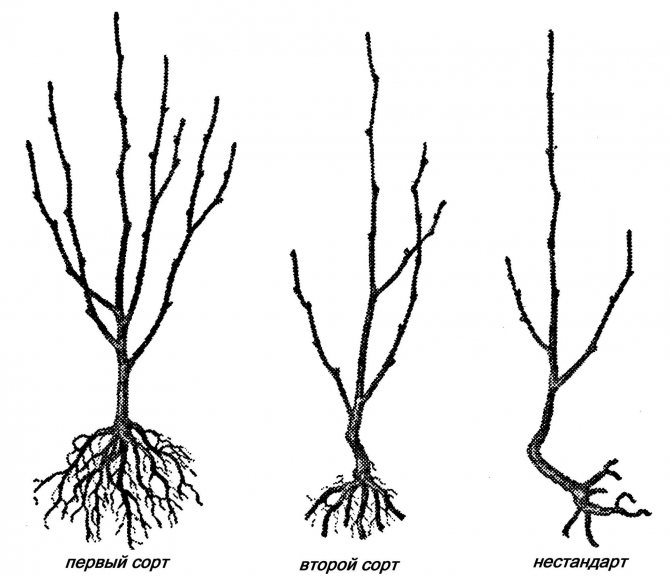

Try to choose the most developed seedling
Landing dates
Cherry Revna can be planted both in spring and autumn, but take into account real weather conditions. It should be remembered that in cold climates, autumn planting (late September - October) is not recommended: the seedling may not have time to take root until frost. In the spring, planting is carried out in April, after the soil has thawed. If the seedling was purchased at the wrong time, you can keep it in a buried hole until spring.
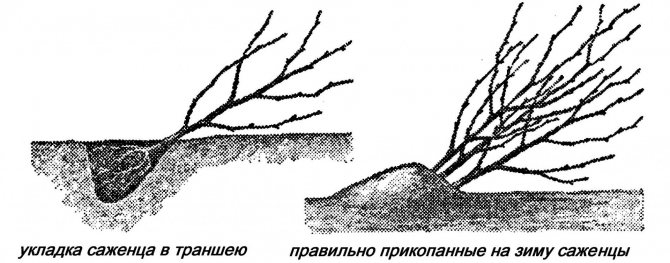

In the trench, the seedling is placed obliquely, and for the winter they are covered with spruce branches
Seat selection
The correct choice of the planting site largely predetermines the further development of the tree. Cherries require strong, fertile soils with good drainage. Places well warmed by the sun, protected from cold winds are preferred.
In regions with a cold climate, it is recommended to plant cherries near buildings and fences - a slightly warmer microclimate is formed there. In addition, in such quiet "nooks" in winter, more snow accumulates to cover the tree.
Sweet cherries, like cherries, do not tolerate excessive moisture. If the groundwater level is less than 1.5–2 m from the soil surface, a tree should be planted on an artificial hill.
The cherry tree requires a lot of space, so the distance to other trees should be at least 4–5 m.
Soil preparation
The soil in the intended area should be prepared well before planting.
First of all, weeds are removed and the soil is dug up to a depth of 20–25 cm. In case of strong infestation with perennial weeds, two-tier digging should be used.
A pit is prepared 2-3 weeks before planting (for spring planting, it is recommended to do this in the fall). The pit should be about 1 m deep and 0.8 m in diameter, the walls should be made even, and the bottom should be loosened. At 1/3 of the depth, the pit should be filled with a nutrient mixture: 2 buckets of fertile soil, 2.5–3 buckets of humus, 0.6–0.8 kg of double superphosphate, 600–700 g of ash, 1–1.5 kg of ammonium sulfate. If the soil on the site is heavy, before filling with the nutrient mixture, pour 2-3 buckets of sand on the bottom of the pit, and for sandy soil, put a layer of clay.
Landing
Planting cherries Revna should be carried out as soon as possible after purchasing a seedling. If it was stored in the hole, remove it from there just before planting.
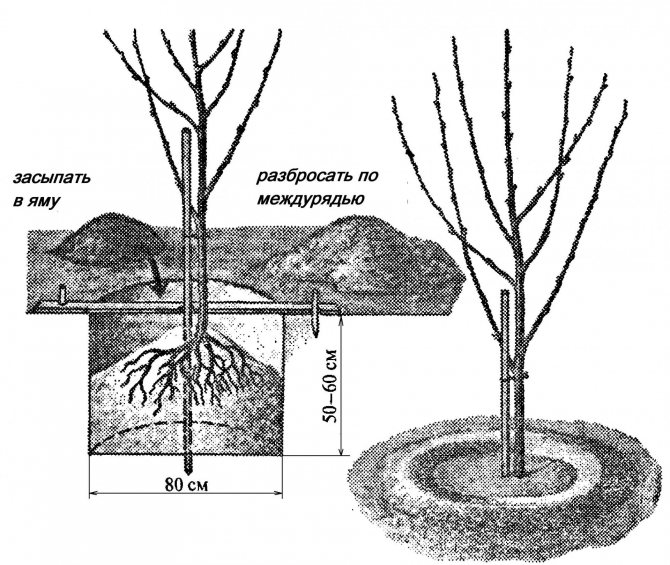

The further development of the tree depends on the correct planting.
Landing is carried out in the following sequence:
- First, install a stake in the pit that will support the seedling.
- Carry out a final close inspection of the seedling, prune dried or broken off roots and twigs.
- Dip the roots in a clay mash.
- Plant a tree on a mound of soil mixture on the north side of the stake, straighten the roots.
- Sprinkle the soil in layers, slightly shaking the seedling so that all the gaps between the roots are evenly filled. Apply each layer with your hands.
- When the hole is full, tamp it down with your foot.
- Tie a tree to a peg.
- Form a hole and pour 2-3 buckets of water into it.
Video: planting cherries Revna
In mid-latitudes, it is better to plant cherries next to a house or other buildings, since a warmer microclimate and additional protection from the wind are formed there.
How to choose a seat
So, above was given a detailed description of the Revna cherry variety. As you can see, this variety is very good. Many summer residents would probably like to plant it on their site. Therefore, next, let's figure out how to properly care for him. Indeed, in order to get a good harvest of even such an unpretentious sweet cherry, it is imperative to follow certain agricultural techniques.
Planting Revna is best on the south side of the garden. This variety can produce good yields only in the presence of a sufficient amount of sunlight. The most suitable types of soils for it are loam and sandy loam. As mentioned, Revna requires pollinators. Of course, if they are not there, the berries will still appear on the tree. But, unfortunately, only in very small quantities (no more than 5% of the potential harvest). The best pollinators for this cherry are:
- Ovstuzhenka.
- Tyutchevka.
- Raditsa.
- Iput.
Choose a place for Revna cherries so that the distance from it to other trees is at least 3 m.
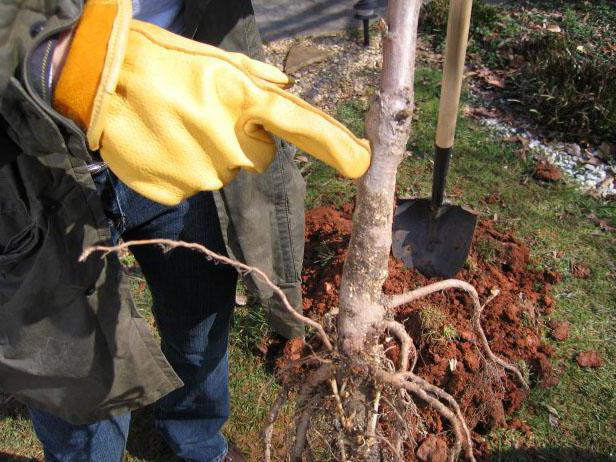

Tree care
For experienced gardeners, caring for the Revna variety is no different from growing other varieties of sweet and sour cherries. If you have chosen the planting site and soil correctly, you will not have to spend a lot of time and effort on watering and loosening.
Soil care
The main thing in caring for the soil for cherries is to eliminate weeds in a timely manner and loosen the soil of the trunk circle, since a sufficient amount of air in the ground is important for the tree. Usually these operations are timed to watering. When the soil begins to dry out after watering, loosening is carried out to a depth of 10-15 cm: this simultaneously allows you to destroy weeds and destroy the soil crust. After loosening, the soil surface is mulched.
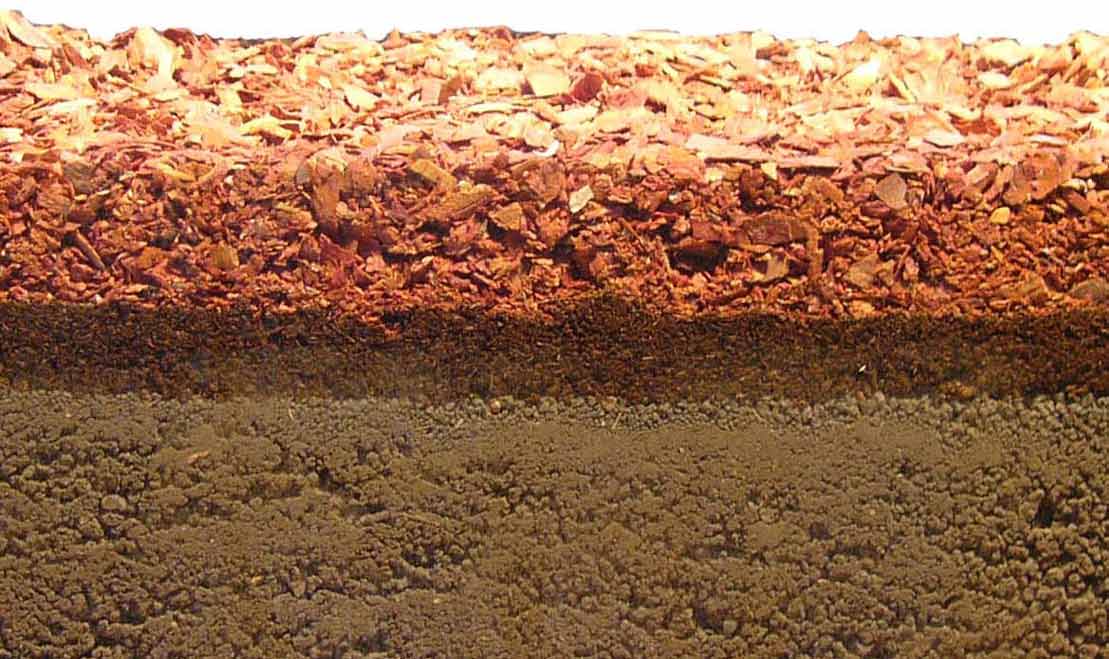

Sawdust mulching keeps moisture in the soil
You can plant strawberries or honey plants (mustard, phacelia) in the aisles - they help to attract pollinating insects.
Watering
Although cherries do not like excess moisture, they need to be watered regularly during the period of active growth of shoots and at the beginning of fruit ripening. If the weather is too dry, water after flowering (early June), then again after 3 weeks. Usually sweet cherries Revna require 4–5 waterings per summer season. The watering rate is 3 to 8 buckets per tree (the upper limit of the rate is for mature large trees). To improve wintering conditions at the end of September, it is necessary to carry out water-charging irrigation (5-6 buckets per square meter).
Cherry pruning
Jealousy practically does not need formative pruning. Nevertheless, in the second year after planting, in the spring, you need to lay a bole with a height of 30-60 cm (the colder the climate, the lower the bole should be). In the first 2 years, all flowers are cut off.
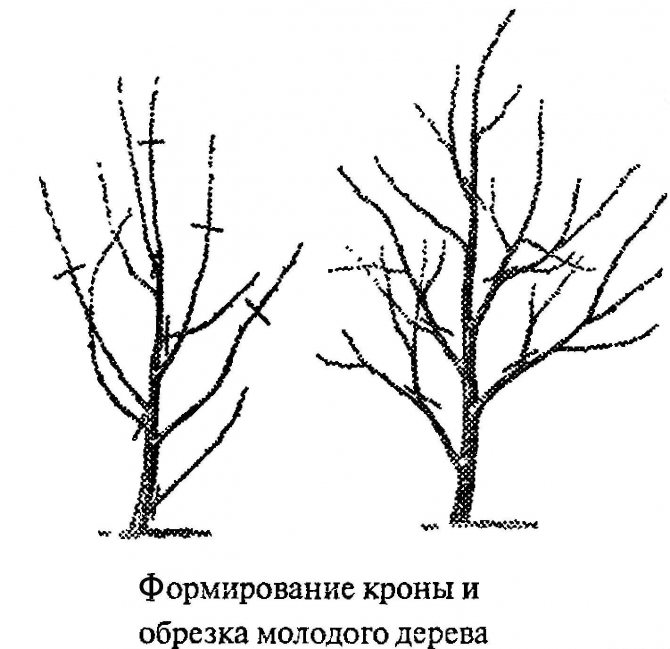

When forming a young sweet cherry, it is necessary to remove incorrectly growing branches and shorten the shoots in order to cause their branching
Until fruiting begins, each year the growth should be shortened by 1/5 of their length. If the growth is too intense (more than 1 m per year), it is shortened by a third of the length and transferred to a side branch.
For a fruiting tree, only sanitary pruning is required to remove dried and diseased branches.Since cherries practically do not thicken, there is no need to thin them out.
Top dressing
For the full development and fruiting of the Revna cherries, regular feeding is required. Usually three dressings per season are enough. Fertilization starts from the 3rd year after planting:
- In the spring, when the buds open, a urea solution is added (8–10 g per 10 l of water). Watering a tree with this solution, try not to get on the root collar (decay may begin).
- During the budding period and during the formation of the ovary, they are fed with potassium-phosphorus fertilizers (15 g of double superphosphate and a glass of ash per bucket of water).
- In the fall, repeat the potassium-phosphorus dressing, already with dry fertilizers (80 g of simple superphosphate and 40 g of potassium sulfate per 1 m2).
Once every 2 years, under the autumn digging of the soil, organic matter is introduced - 3-4 buckets of humus or compost.
Preparing for winter
Jealous is very frost-resistant, she does not need special insulation. Still, the roots of young trees should be protected with a thick layer of sawdust or peat mulch. In autumn, the trunk and main branches are whitewashed with a lime solution (lime and clay in a 1: 1 ratio with the addition of a small amount of wood glue, dilute with water until sour cream is thick).
Cherry pests and diseases
Cherry Revna is resistant to fungal diseases. But besides them, there are a number of other diseases that can damage the tree, not to mention harmful insects.
Birds are special pests. They can be scared away by hanging Christmas tree tinsel on the tree. Until the tree has reached a large size, it can be sheltered from birds with a net.
Table: Revna cherry diseases and their treatment
| Name | Description | Method of struggle |
| Milky shine | Branches and leaves are affected. The color of the leaves becomes lead-white, the wood on the cut - with brown or purple spots. Purple mushrooms grow on the bark of dried branches. Without treatment, the tree dies. |
|
| Necrotic ring spot | Brown spots appear on the branches, the affected tissues fall out. The disease is spread by pollen or by vaccination. May cause a 50% reduction in yield. |
|
| Gum therapy (gommosis) | Resin (gum) streaks appear on the bark. If severely damaged, the tree may die. Trees that are deprived of proper care, as well as weakened by wintering, are especially often affected. |
|
Photos will help determine the presence of the disease by the appearance of the leaves and trunk. Regular inspection of cherries helps early detection of problems, which will allow the tree to heal faster.
Photo gallery: diseases of cherries Revna
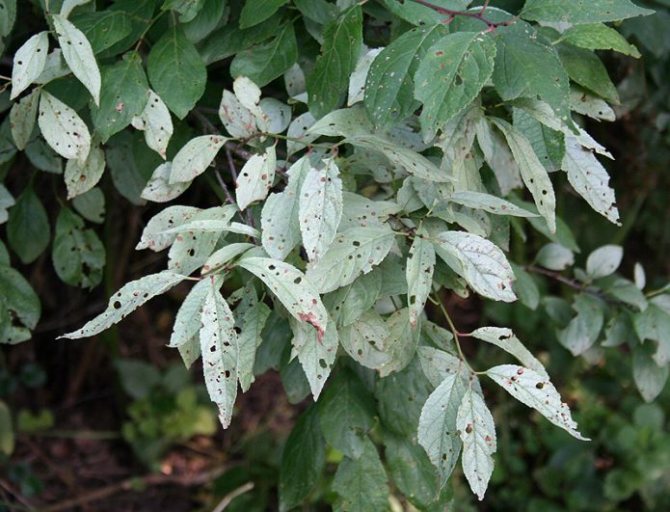

Milky sheen is manifested in a change in the color of the leaves.
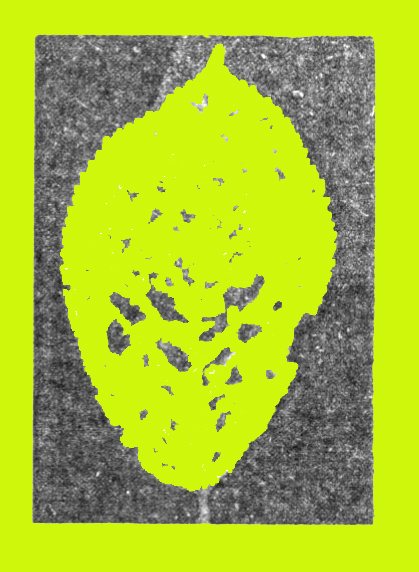

Ring spot infestation can reduce yield by 50%
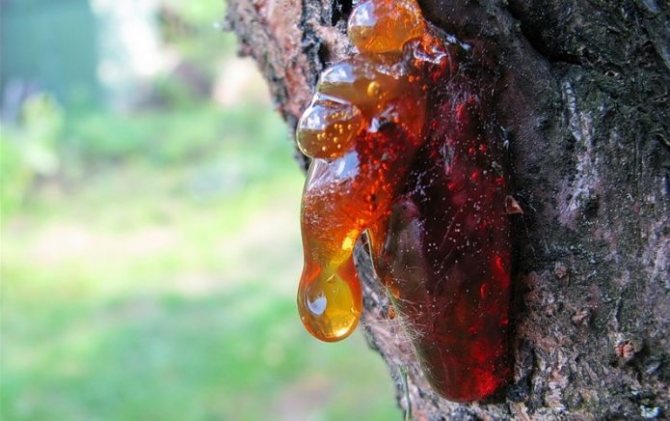

Gum damage affects trees under adverse weather conditions and poor maintenance
The pest in the Revna cherry is the same as in other varieties of sweet cherries and cherries. Therefore, the means of struggle are universal.
Table: cherry pests and methods of dealing with them
| Pest | Characteristics of the pest and damage | Method of struggle |
| Cherry elephant | A small (5–9 mm) beetle of crimson color with a golden sheen, the head is covered with “gray” hairs. It lays eggs in the ovary, the larva gnaws at the core of the bone.The next year young bugs eat leaves, buds, ovaries. |
|
| Cherry fly | The insect, which looks like a common fly, lays eggs near the fetus. The larva penetrates the berry and destroys it - what it doesn’t eat, it will spoil it with its excrement. |
|
| California scabbard | On the branches and trunk, massive clusters of small round insects are visible, covered with a reddish-brown shield. Suck the juice from the shoots. | Treat in the spring, then again in the second half of July with Iskra, Inta-vir, Aliot. |
Regular inspection of the tree and fruits will help to identify the presence of insect pests.
Photo gallery: pests of cherries Revna
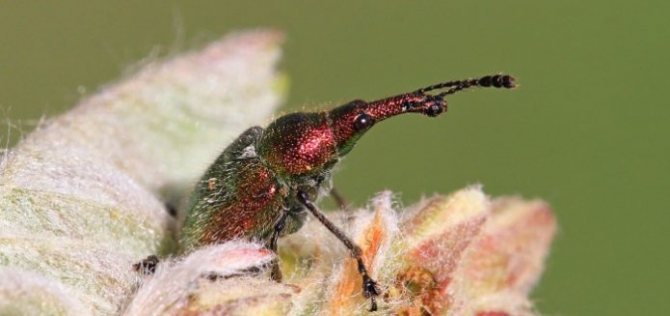

Both the elephant itself and its larvae actively damage the ovaries, buds and leaves of sweet cherry
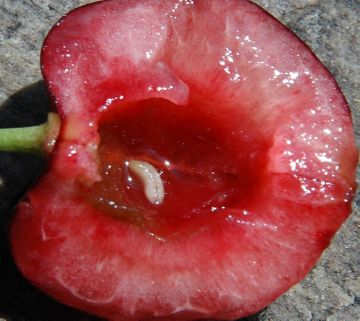

The cherry fly lays eggs near the ovaries, and then the larva gnaws the flesh
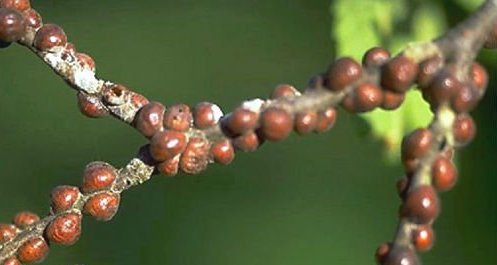

Scabbard is one of the most common sucking pests
In the fight against diseases and pests, both chemical and folk remedies can be used, but the latter, although cheaper, are not always effective enough.
Harvesting, storing and using the harvest of Revna
Revna fruits begin to ripen in late June - early July. The berries should be picked in several stages as they ripen. Harvesting is done by hand, preferably in the morning, in dry weather. For storage and transportation, the berries should be picked together with the stalk. Can be harvested without petioles if processed immediately. The berries break off from the stalk "dry", do not flow.
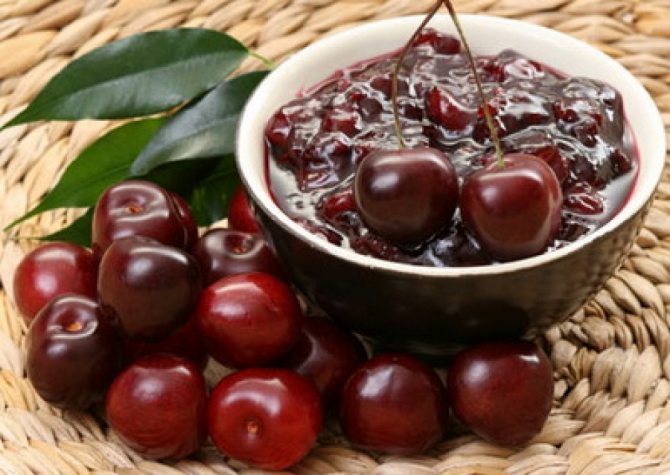

Sweet and aromatic jam is made from cherries.
Sweet cherries are not stored for long - in the refrigerator at a temperature of 0 ... + 3 ° C, the berries will lie no more than 2 weeks. At room temperature - no more than 1-2 days.
Revna has a dessert taste (tasting score of 4.9 points out of 5 possible), while it can be consumed not only fresh, but also to make jams, juices and compotes.
Yield
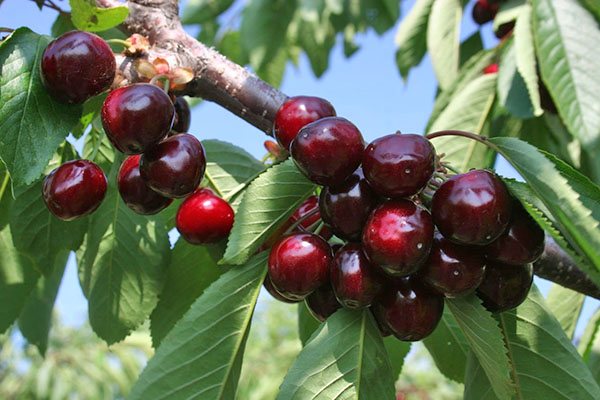

Each tree gives about 15-25 kg of ripe fruits, and the tree gives its first harvest 5 years after planting. After picking, the berries must be stored in a dry, cold place, since the berries will quickly become unusable in the warmth.
To increase the shelf life of berries, you can use freezing (freezing affects the taste rather weakly). The fruits of the Revna cherry can be eaten. You can make compote, jam, homemade wine and so on from Revna cherries.

